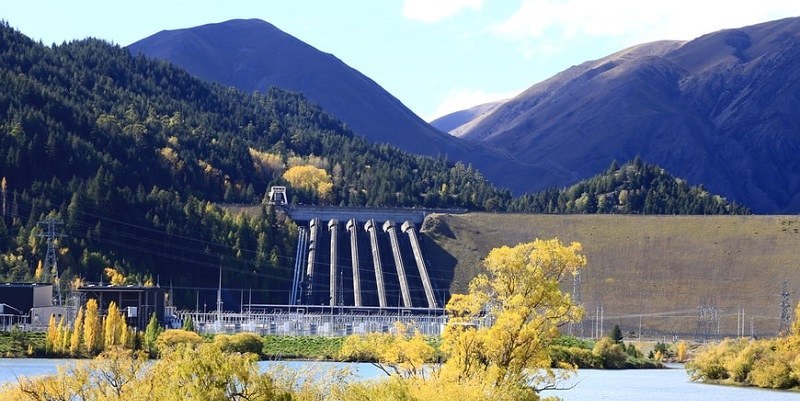Hydroelectric Power: Overview of the Concept
The energy produced by generators operated by turbines that transform the potential energy of falling or fast-flowing water into mechanical energy is widely known as hydroelectric power. Hydroelectric power was by far the most frequently used way to generate electricity at the beginning of the twenty-first century, accounting for more than 18 percent of the world's total power generating capacity in 2019. So, how can we harness the power of water to generate electricity?
Coal-fired and hydroelectric power stations both generate energy in the same way. In both situations, a power source is utilized to spin a turbine, a propeller-like component that subsequently rotates a metal shaft in an electric generator, which generates energy. The turbine blades of a coal-fired power plant are turned by steam, whereas the turbine blades in a hydroelectric facility are turned by falling water. The results are the same.
Built-in dams enclose rivers, boosting water levels behind the dam and creating as much head as possible. Because the quantity of energy that can be taken from a volume of water is directly related to the operating head, a high-head system requires less water than a low-head design to produce the same amount of energy. The powerhouse is erected on one side of the dam, with a part of the dam functioning as a spillway to evacuate surplus water during floods in certain dams. The powerhouse may be positioned within the dam itself if the river runs through a tight, steep valley.
The demand for electricity in most towns fluctuates dramatically throughout the day. Pumped-storage hydroelectric facilities are periodically developed to distribute the load on the generators. During subdued hours, part of the surplus electricity is sent to the generator, which is used as a motor to drive the turbine, which pumps water into an elevated tank. Indeed, the water is then permitted to run down through the turbine during moments of high demand, generating electricity. Pumped-storage systems are effective and cost-effective for meeting peak demand.

Hydroelectric power stations have been built to make use of the ebb and flow of tides in particular coastal places, such as the Rance River delta in Brittany, France. Water is pumped into one or more tanks when the tide flows in. The water in these reservoirs is discharged at low tide to power hydraulic turbines and electric generators.
Impoundment, diversion, and pumped storage are the three types of hydroelectric facilities. Dams are used in certain hydroelectric facilities, although they are not used in others.
An impoundment facility is the most prevalent form of the hydroelectric power plant. A dam is used to hold river water in a reservoir at an impoundment plant, which is usually a big hydroelectric system. When water from the reservoir is released, it drives a turbine, which activates a generator, which generates energy. Under these circumstances, the water might be released to satisfy changing electrical demands, as well as other purposes including flood control, recreation, fish passage, and other environmental and water quality concerns.
A diversion, commonly known as a "run-of-river" facility, directs a section of a river via a canal and/or a penstock to generate electricity by utilizing the natural drop in riverbed height. Water flow is controlled by gates, valves, and turbines in a penstock, which is a closed tube that sends water to turbines. A dam may not be required for a diversion.
Pumped storage hydropower, or PSH, is a kind of hydropower that functions as a large battery. A PSH plant may store electricity generated by alternative energy sources such as solar, wind, and nuclear power for later use. These plants store energy by pumping water from a lower elevation reservoir to a higher-elevation reservoir. A PSH facility stores energy by pumping water from a lower reservoir to an upper reservoir when power demand is low. Water is dumped into the lower reservoir at times of high demand when it drives a turbine that generates energy.

Globally, the technological potential for hydropower expansion is far larger than current production: 71% of potential hydropower capacity in Europe, 75% in North America, 79 percent in South America, 95% in Africa, 95% in the Middle East, and 82 percent in Asia-Pacific has yet to be developed. Because of the political realities of new reservoirs in western countries, economic constraints in the third world, and the lack of a transmission system in underdeveloped areas, only around a quarter of the remaining technically exploitable potential can be realized before 2050, the bulk of which is centered in Asia-Pacific. Some nations' hydroelectric potential has been fully utilized, leaving limited space for expansion: Switzerland produces 88 percent of its capacity, while Mexico produces 80 percent.
Hydropower plants may be used to provide both baseload and balancing power (the amount of electricity that is always required, electricity output that can quickly be turned on to meet variations in demand). One issue with electricity is that it cannot be stored in large quantities. Water, on the other hand, has the potential to do so. Large natural "batteries" serve as water reservoirs near hydropower facilities. Energy may be stored during times of the year when water input is high but electrical demand is low, and then utilized when demand is highest. That is why hydroelectric power is considered to be one of the most efficient and with the greatest potential.
